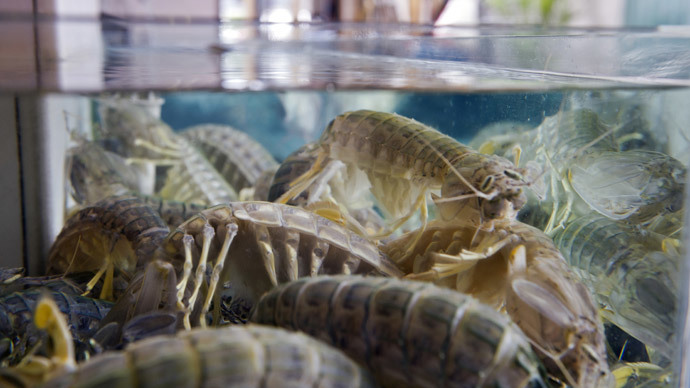
© AFP Photo / Alex OgleMantis shrimp.
The brilliant natural design of the Mantis shrimp's eyes allows the colorful crustacean to see cancer within our bodies. Now, scientists in Australia have reproduced the critters amazing ability in a camera that might one day be put in your smartphone.
Researchers from the University of Queensland in Australia
announced the discovery earlier this week, which could revolutionize the way we detect one of the top global killers.
The mantis shrimp has one of the most elaborate visual systems ever discovered. Researchers at the university found that the shrimp's compound eyes are perfectly designed to detect polarized light, which reflects differently off of different types of tissues, including those of the cancerous or healthy variety.
"We see color with hues and shades, and objects that contrast - a red apple in a green tree for example - but our research is revealing a number of animals that use polarized light to detect and discriminate between objects," Professor Justin Marshall, from the Queensland Brain Institute at the University of Queensland, said in a press release.
The shrimp's amazingly complex eye has provided a perfect template for scientists to develop their own technology.
"Nature has coming up with elegant and efficient design principles, so we are combining the mantis shrimp's millions of years of evolution - nature's engineering - with our relatively few years of work with the technology."
Marshall says a camera they've developed with an international team has the ability to convert otherwise invisible messages into "colors that our visual system is comfortable with."
"The camera that we've developed in close collaboration with US and UK scientists shoots video and could provide immediate feedback on detecting cancer and monitoring the activity of exposed nerve cells," he said.
The team hopes that one day the technology will be expanded so that such cameras can be placed in smartphones, allowing people to scan their bodies for cancer in the comfort of their own homes.
Although current imaging systems already exist which utilize polarized light to detect cancer, they are limited in terms of the tumor sizes they can detect. The equipment is also bulky and cost prohibitive.
By developing a portable and affordable version of the technology, invasive procedures like biopsies could become a thing of the past, while countless lives could potentially be saved through early detection.
The sensors developed by the Queensland team have already been used to capture images of neural activity inside the brain. They have also successfully diagnosed early stages of cancer in mice.
Researchers including Dr Viktor Gruev from Washington University, and others from the Washington University School of Medicine, the University of Maryland Baltimore County and the University of Bristol are also helping to hone the technology.
"The combined team is a good example of how interdisciplinary collaboration in science - between visual neuroscience, physics and electro-optical engineering - can provide really productive new approaches," Marshall said.
"My expertise is in finding and describing the design components of the visual systems in nature and then recognizing where the engineers may use these natural innovations."
Speaking with The Sydney Morning Herald, Marshall said the technology would bring benefit beyond cancer research.
"Aside from the cancer part of this story, you can see nerve cells firing in polarization that you can't see normally. By tapping in to this visual system that animals have and we don't have, we can improve our own technologies in different areas," he told the paper.
On a more philosophical note, he said that as a professional dedicated to getting "in the head of another animal," these creatures can help us change the way we see the world, not only literally, but figuratively as well.
"It's interesting that they've got little brains and we've got big brains and we tend to think we're the pinnacle of evolution and the world appears to us the way it is and that's it," he said.
"That's clearly not the case and there's animals out there using all sorts of information that we don't have access to."
Been a BIG fan of these unbelievably beautiful (and deadly!) creatures for decades now, when a friend who long ago worked in a pet shop turned me on to these lovely, but very ferocious shrimpies. And they're HUGE, too (some get over 12" long, I've been told.)
They really are quite incredible, actually, especially their means of stunning prey.
Apparently, these guys can strike prey with their claws at such speed and force that they blast out nearly hyper-sonic shock waves that (along with the striking force) can easily stun/kill potential meals or predators, and, in case of a home aquarium, can literally blow out the glass if they let loose in too close proximity to their enclosure boundaries. I believe re-inforced glass is highly recommended for Mantis Shrimp fanciers. (And VERY careful handling procedures, too, I might add!)
They are not endangered (thankfully) and not all are so brilliantly colored like a few really incredible sub-groups, but as far as wild and crazy sea creatures go, these Mantis Shrimp are right up there, and deserve all the great ink spilled their way.
(And we won't even mention they have the world's most evolved eyes......)
Possibly helping mankind to find and cure cancer easily and quickly? All in a day's work for the... INCREDIBLE MANTIS SHRIMP!
(See, they really do rock.)